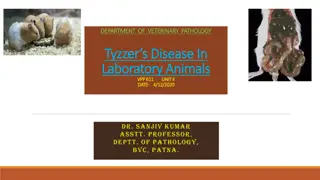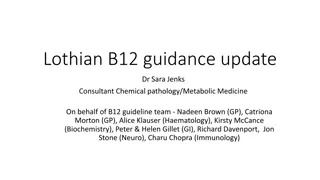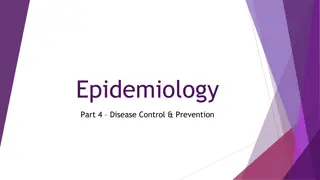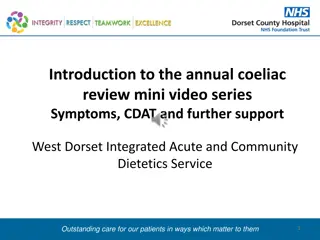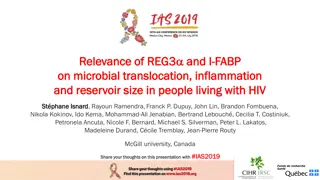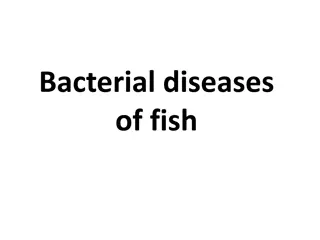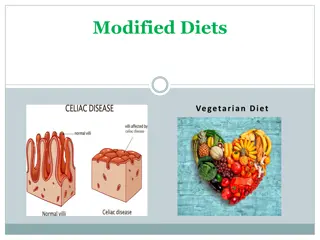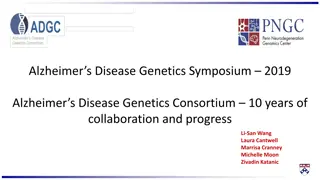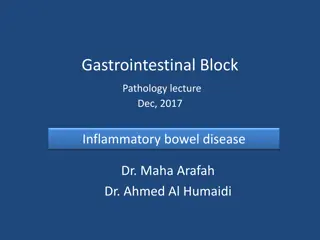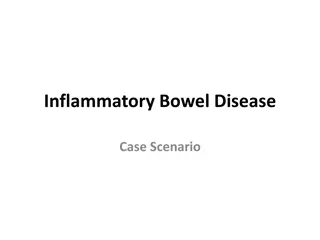Exploring the History and Evolution of Coeliac Disease
Samuel Gee's pivotal clinical description of coeliac disease in 1887 unraveled a chain of discoveries leading to the understanding of its genetic and immunological roots. Early connections between wheat and the disease shed light on the domestication of wheat and its impact on human health. Recent insights from a palaeodiet reconstruction highlight the ancient origins of coeliac disease and its genetic underpinnings, showing over 40 associated genes and unique adaptations. The rise in coeliac disease since the 1980s prompts questions about its complex triggers, beyond simple factors like wheat consumption or modern wheat toxicity.
Download Presentation

Please find below an Image/Link to download the presentation.
The content on the website is provided AS IS for your information and personal use only. It may not be sold, licensed, or shared on other websites without obtaining consent from the author.If you encounter any issues during the download, it is possible that the publisher has removed the file from their server.
You are allowed to download the files provided on this website for personal or commercial use, subject to the condition that they are used lawfully. All files are the property of their respective owners.
The content on the website is provided AS IS for your information and personal use only. It may not be sold, licensed, or shared on other websites without obtaining consent from the author.
E N D
Presentation Transcript
Why do I have Coeliac Disease? Gluten Free Prescribing in England Vitamin D and calcium requirements DXA scan Annual review Screening Vaccinations
Early history Evolution Genetic Immunology
Samuel Gee (1887) is credited with the first clinical description of coeliac disease Coeliac disease was first described by Aretaeus of Cappadocia 10,000 years ago Dr Willem Dicke found that some malnourished children with coeliac disease improved during the Dutch Famine (1944-45) but deteriorated when bread was reintroduced A connection was made between wheat and coeliac disease He put 3 patients on a balanced diet with/without wheat starch which led to the discovery of the cause of coeliac disease and the first gluten free diet The early 1960 s saw the discovery of the antigliadin antibodies and was the first non invasive serology markers for coeliac disease
It is considered that civilisation occurred due to improved nutrition related to the domestication of wheat Our common bread wheat evolved from wild einkorn wheat and goat grass leading to emmer wheat which is the first known domesticated wheat. The proteins in wheat caused an immune reaction in coeliac patients
A palaeodiet reconstruction (2010) and bone analysis on a skeleton of a young Italian woman from 1stcentury AD with malnutrition, stunted growth with probable iron deficiency - found the HLA DQ2 gene present and is the first documented case of coeliac disease There are over 40 genes associated with coeliac disease with evidence that positive selection of harmful genes has occurred to help respond to bacterial or infections organisms (links to Justinian Plague 1400 years ago!)
Coeliac disease started to increase in the 1980s why? Is it due to an increase in wheat consumption? NO wheat consumption peaked in the1880 s Is it due to toxic modern wheat? NO modern wheats are less immunogenic Maternal wheat intake or breast feeding ? NO evidence Infant gluten consumption? NO evidence re timing of introduction of gluten Dietary patterns after weaning? ? A normal healthy diet may reduce development of CD more studies Microbiome? NO evidence of early introduction of antibiotics Caesarean section? NO association with c section and vaginal deliveries
Hook worms Coeliac patients infected with hook worms and reintroduced to gluten had no deterioration in their condition Flu virus 1-2 years post virus Rotavirus after vaccination Reovirus responses to dietary antigens and development of CD Hook worms do they protect? Flu virus 30% increase risk of developing CD Rotavirus 40% risk reduction in children Reovirus infection triggers inflammatory
The origins of CD lie in the origins of agriculture and the birth of human civilisation Gene variants associated with CD have persisted due to balancing or positive selection driven by infectious diseases CD has become more common in the late 20th century We still don t really know why Viral infections are likely to play a role in triggering CD A vaccine in America is in phase 2 of study and is looking promising.
National consultation with over 8000 responses, 1000 from healthcare professionals Consultation response published in February 2018 recognising and acknowledging concerns re cost, availability, adherence and support The government s preferred option is to retain a limited range of bread and mix products on prescription
127 CCGs including NEW Devon CCG have already altered the way they prescribe. NEW Devon have stopped all adult prescriptions for gluten free products The consultation outcome does not require them to reverse this decision. NEW Devon haven t commented on whether they will change as yet.
Task and Finish Group has been formed with the BDA, Coeliac UK, RCGP, RCPCH and manufacturer involvement. to provide advice to the Department on implementing the changes to the availability of GF food in primary care. This will include, but not limited to; product list streamlining, pricing, suitability of products for a range of patients, update to the clinical indication, appropriate communications and alternative supply routes
Improving the existing model ie GP prescription taken to pharmacy Pharmacy led Dietitian led Pharmacy voucher Supermarket voucher Annual top up card for GF products keep spend under control.
Coeliac UK are contacting all CCGs identifying where access has been restricted and challenging CCG s to review and reverse these decisions. The BDA are supporting these efforts by providing local dietitians with materials to help them approach their local CCG s
Vitamin D helps the body absorb calcium and is needed to keep bones and teeth healthy It is made by the skin when exposed to sunlight and it is found in oily fish, egg yolk, meat, offal, milk fortified margarines/breakfast cereals and cod liver oil. Public Health England recommend everyone in the general population over the age of 4 to take a daily supplement of 10 micrograms of vitamin D from October to February. There are no specific recommendations on vitamin D intake for people with CD. Current advice is the same as for the general population
On average 19-64 year olds consume a third of their daily recommended intake Adults can develop osteomalacia ( soft bones, bone pain and muscle weakness) if they do not get enough vitamin D Supplements are widely available to buy from pharmacies, supermarkets and health food shops If you are already on a calcium supplement check it isn t already combined with vitamin D, it is important not to have more than 1 supplement containing vitamin D. There is no problem taking a vitamin D supplement alongside spending time in the sun as the body will only make what it needs.
People with CD may have an increased need for calcium compared to the general adult population Adults with CD should have at least 1000mg calcium/day compared to 700mg for the general population If you can t get all the calcium you need from your diet and your calcium levels are low you may need to take a calcium supplement. Speak to your doctor or dietitian for further advice Your consultant will be able to advise if you require medication (biophosphates) to lower the risk of bones breaking, this will usually follow a DXA scan
248mg 244mg 230mg 220mg 170mg 170mg 105mg 70mg 32mg 200ml skimmed milk 200ml s skimmed milk can tinned sardines 30 g cheddar cheese 2 tsp sesame seeds 125g pot yoghurt tin baked beans 1 orange 3 tblsp broccoli Portion size of food Calcium content/portion
If you have coeliacs disease you are identified as high risk of developing osteoporosis and fragility fractures DXA scans are offered to: >50 yrs with a history of fragility fractures <40 yrs with a major risk factor eg CD Other groups with a 10 yr fragility fracture risk of 10% Repeat scan appropriate to individual but usually within 2 years
The following should be covered: Ensure adequate advice and information on CD and gluten free diets have been received and assess adherence to diet Assess for symptoms and signs of CD, its complications and associated conditions eg GI symptoms, BMI, osteoporosis risk Consider annual blood testing If diarrhoea and/or other symptoms recur or persist on a strict GF diet consider diagnosis Referral back to gastroenterologist if there are signs of complications/persistent symptoms Referral to dietitian if it s difficult to asses adherence to GF diet Offer immunisations Offer more frequent review if there is a clinical need eg pregnancy
CD fulfils many but not all of the WHO criteria for screening. There is insufficient evidence to recommend population screening however testing should be carried out on:- Symptomatic first degree relatives (10% prevalence) High risk groups iron deficiency anaemia, Down s syndrome, T1 Diabetes, osteoporosis and IBS (2-5% prevalence)
Some people with coeliac disease have been found to be hyposplenic potentially putting them at risk of pneumococcal infections. Based on advice from the Health Advisory Council (HAC), Coeliac UK recommends that everyone with coeliac disease is vaccinated against pneumococcal infection The BSG Guidelines for the diagnosis and management of adult coeliac disease (2014) recommend patients newly diagnosed with coeliac disease have the pneumococcal vaccine, this is a one off injection.







